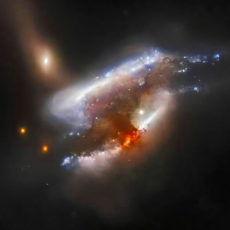
NASA / ESA’s Hubble Space Telescope observed an event, GW170817, that involved a collision between two neutron stars, which are the cores of massive supergiant stars. The energy released was so massive that it would match that of a supernova explosion, resulting in a jet propelled through space at nearly the speed of light.
After the explosion, researchers pointed Hubble at the direction of GW170817 two days later, and observed the aftermath. They discovered that the neutron stars collapsed into a black hole, which pulled materials toward it, resulting in a rapidly-spinning disk that produces jets moving outwards from its poles. This jet continued to smash and sweep up material in the explosion debris, including a blob from which this impossibly fast jet emerged.
- BRIGHT, SHARP VIEWS ANYWHERE: Unlike many beginner telescopes, this quality refractor features fully coated glass lenses and a 70mm aperture for...
- PERFECT FIRST TELESCOPE FOR BEGINNERS: Designed for adults and kids to enjoy together, this beginner-friendly telescope sets up in minutes and...
- EASY NO-TOOL SETUP: No complicated assembly or tools needed. The full-height tripod and telescope tube set up in seconds and pack neatly into the...
I’m amazed that Hubble could give us such a precise measurement, which rivals the precision achieved by powerful radio VLBI telescopes spread across the globe,” said Kunal P. Mooley, lead author of paper from Caltech in Pasadena, California.






